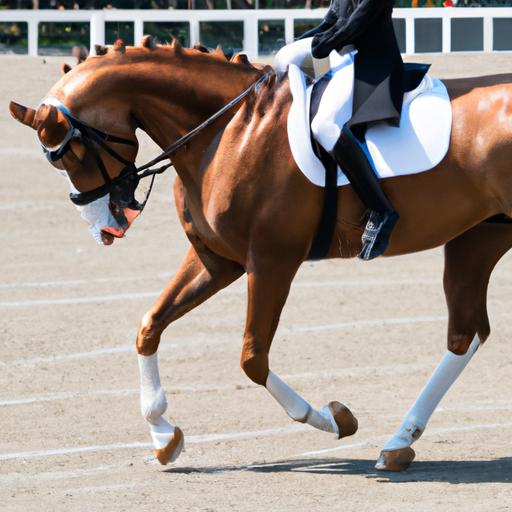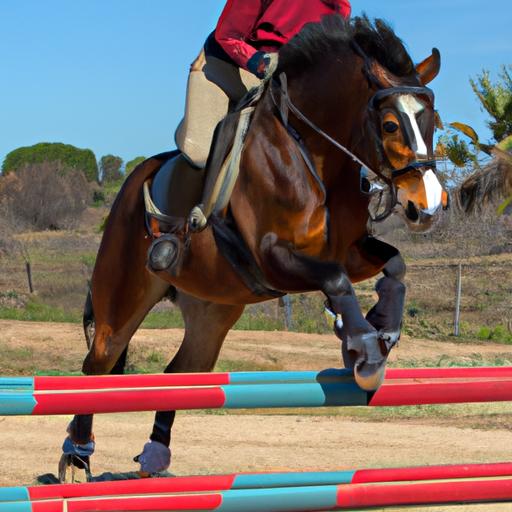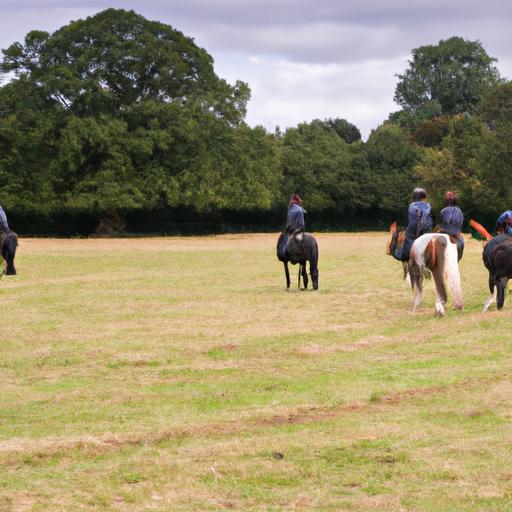Discover the secrets of successful horse training drills! Learn how to establish a consistent routine, warm-up effectively, and monitor progress for optimal results.
Are you ready to take your horse training to the next level? If you’re looking to enhance your bond with your equine companion and elevate their skills, then incorporating horse training drills into your routine is the key. In this article, I will guide you through the fascinating world of horse training drills and uncover the remarkable benefits they offer.
From seasoned equestrians to novice riders, everyone can benefit from the structured approach that horse training drills provide. By breaking down complex maneuvers into manageable exercises, drills enhance communication between you and your horse, fostering a deeper understanding and trust. Whether you’re aiming to improve your horse’s balance, coordination, precision, or confidence, training drills are a powerful tool in your equestrian arsenal.
So, why should you consider integrating horse training drills into your training sessions? The advantages are manifold. Firstly, drills offer a systematic approach to address specific areas of improvement, allowing you to focus on refining particular skills. Secondly, by incorporating drills, you create a structured training plan that adds variety and keeps both you and your horse engaged. It’s like embarking on an exciting journey together, filled with challenges and rewards.
Moreover, horse training drills provide a solid foundation for further training endeavors. By mastering the basics through groundwork exercises, you establish trust and mutual respect, laying the groundwork for more advanced skills. Dressage exercises can enhance your horse’s balance and coordination, transforming them into graceful performers. Jumping drills, on the other hand, refine technique and precision, ensuring flawless execution over fences. And let’s not forget the importance of trail training drills, which instill confidence and adaptability in your equine companion.
Incorporating horse training drills into your routine is like unlocking the hidden potential within your equine partner. It’s an opportunity to build a stronger bond, refine skills, and achieve new heights together. So, let’s delve deeper into the realm of essential horse training drills and discover how to design effective training plans that cater to your horse’s individual needs. Stay tuned for the next section, where we’ll explore the fundamental groundwork exercises for building trust and respect. Let’s embark on this transformative journey and unlock the true mastery of horsemanship.
Remember, Horsemasterypro.com is your go-to resource for all things equestrian.
Understanding Horse Training Drills

Definition and Purpose of Horse Training Drills
When we talk about horse training drills, we refer to a series of structured exercises designed to improve specific aspects of your horse’s training. These drills break down complex maneuvers into smaller, manageable tasks, allowing you to focus on refining individual skills. By incorporating drills into your training routine, you create a systematic approach that enhances both you and your horse’s understanding and performance.
The purpose of horse training drills is multifaceted. Not only do they provide a methodical way to address areas of improvement, but they also foster effective communication between you and your equine partner. As you engage in these exercises, you’ll learn to interpret your horse’s responses and cues, establishing a deep level of trust and mutual understanding. This improved communication will enhance your overall partnership and allow you to achieve higher levels of performance.
How Drills Can Improve Communication Between Horse and Rider
Imagine having a conversation with your horse without exchanging a single word. Through horse training drills, you can develop a unique language of cues, signals, and body language that enables seamless communication between you and your equine companion. By consistently practicing these drills, you’ll refine your aids and become more attuned to your horse’s responses, creating a harmonious and synchronized partnership.
Drills provide a structured framework for developing clear and precise communication. For example, while working on lateral movements, such as leg yields or shoulder-ins, you’re teaching your horse to respond to subtle aids and cues. Over time, this strengthens your connection and enables you to guide your horse effortlessly through intricate maneuvers. As you and your horse become more proficient in these drills, you’ll experience a sense of unity and flow that’s truly remarkable.
Different Types of Horse Training Drills
Horse training drills encompass a wide range of exercises that cater to various aspects of equine development. Some common types of drills include groundwork exercises, dressage exercises, jumping drills, and trail training drills. Each type serves a specific purpose and contributes to the overall development of your horse’s skills.
Groundwork exercises focus on building trust, respect, and establishing a solid foundation. These exercises involve activities such as leading, lunging, and desensitization, which develop your horse’s responsiveness and obedience from the ground up.
Dressage exercises aim to improve your horse’s balance, suppleness, and collection. These drills involve precise movements, such as circles, leg-yields, and half-passes, which enhance your horse’s athleticism and coordination.
Jumping drills, as the name suggests, focus on improving your horse’s jumping technique, accuracy, and confidence. Exercises like gridwork, related distances, and gymnastics help your horse navigate fences with ease and grace.
Trail training drills introduce your horse to various obstacles and challenging environments, preparing them for outdoor adventures and enhancing their adaptability.
By incorporating a variety of horse training drills into your routine, you can holistically develop your horse’s skills and create a well-rounded, versatile partner. In the next section, we’ll explore some essential groundwork exercises that lay the foundation for a successful training journey. Let’s dive in!
Essential Horse Training Drills

Basic Groundwork Exercises: Building Trust and Respect
Before embarking on any advanced training, it is crucial to establish a solid foundation of trust and respect with your equine partner. Basic groundwork exercises form the cornerstone of this relationship-building process. Through these exercises, you’ll develop clear communication, reinforce boundaries, and establish a strong bond.
Start with leading exercises, teaching your horse to walk respectfully beside you, halt on command, and back up when asked. This builds trust and establishes you as the confident leader. Next, move on to lunging drills, which promote obedience, responsiveness, and the development of proper gaits. With lunging, you can work on transitions, circles, and changes of direction, refining your horse’s coordination and balance.
Dressage Exercises: Enhancing Balance and Coordination
Dressage drills are not solely reserved for the competitive dressage arena. These exercises are incredibly beneficial for all riders, regardless of their discipline. Dressage focuses on developing your horse’s balance, suppleness, and collection, resulting in improved overall athleticism.
One effective drill is shoulder-in, where your horse moves forward with their shoulder slightly leading the rest of their body. This exercise enhances engagement, improves lateral flexibility, and strengthens the inside hind leg. Leg yielding is another valuable drill that enhances lateral movement and promotes straightness. It involves asking your horse to move sideways, crossing their legs over, and maintaining a steady rhythm.
Jumping Drills: Improving Technique and Precision
For those with a passion for jumping, incorporating specific drills can elevate your horse’s technique and precision over fences. Gridwork is a popular drill that involves a series of jumps set at specific distances. This exercise develops your horse’s ability to find the correct take-off point, maintain an even rhythm, and improve their jumping form.
Another valuable drill is the bounce exercise, where you set two or more jumps close together, requiring your horse to jump in quick succession without taking strides in between. This drill enhances your horse’s agility, responsiveness, and adjustability, preparing them for more challenging jumping courses.
Trail Training Drills: A Well-Rounded and Confident Horse
Trail training drills not only expose your horse to different environments but also enhance their confidence and adaptability. Incorporating trail obstacles into your training routine helps simulate real-life scenarios, preparing your horse to confidently tackle any challenge that may arise.
Start with simple trail obstacles such as crossing bridges, stepping over logs, or maneuvering through gates. Gradually progress to more complex obstacles like water crossings, tarps, or navigating tight spaces. These drills develop your horse’s bravery, problem-solving skills, and overall versatility.
By incorporating these essential horse training drills into your routine, you’ll build a solid foundation, enhance balance and coordination, refine jumping technique, and foster a well-rounded and confident equine partner. In the next section, we’ll delve into the process of designing effective horse training drills tailored to your horse’s unique needs. Stay tuned and let’s continue this transformative journey together.
Designing Effective Horse Training Drills
Assessing the Horse’s Current Skill Level and Training Goals
Before diving into designing horse training drills, it is crucial to assess your horse’s current skill level and identify specific training goals. Understanding where your horse stands in terms of abilities and areas that need improvement will help you tailor the drills to their needs. Are they a beginner, intermediate, or advanced level horse? Are there any specific skills or behaviors you want to focus on? By conducting this assessment, you can create a training plan that is both realistic and effective.
Setting Specific Objectives for Each Drill
To ensure maximum progress and engagement, it is important to set specific objectives for each drill. Instead of vague goals like “improve jumping,” break it down into smaller, achievable targets such as “enhance take-off technique” or “refine landing position.” Clear objectives provide direction and allow you to track your horse’s progress more effectively. Remember, setting small, attainable goals will build confidence and motivation for both you and your horse.
Creating a Structured Training Plan Incorporating a Variety of Drills
A structured training plan is vital when designing effective horse training drills. It provides a roadmap for your training sessions and ensures a balanced approach to addressing different aspects of your horse’s training. Incorporate a variety of drills that target various skills, such as groundwork, dressage, jumping, and trail training. This diversity keeps your horse engaged and prevents monotony. Schedule specific drill sessions regularly and allocate sufficient time for each drill, allowing for gradual improvement and reinforcement of skills.
Adapting Drills to Suit Individual Horse’s Needs
Every horse is unique, and their training needs may vary. It is essential to adapt drills to suit your horse’s individual requirements. Take into consideration their temperament, physical abilities, and any specific challenges they may have. For example, if your horse tends to be anxious, start with low-pressure groundwork exercises to build confidence. If your horse has physical limitations, modify the drills to accommodate their abilities. By tailoring the drills to your horse’s specific needs, you can optimize their training experience and ensure progress in a safe and effective manner.
By following these steps, you can design horse training drills that are tailored to your horse’s abilities, objectives, and individual needs. In the next section, we will delve into valuable tips for successfully implementing these drills and ensuring a productive and enjoyable training experience. Stay tuned as we explore the secrets to unlocking your horse’s full potential. Remember, horsemasterypro.com is your trusted source for all things equestrian.
Conclusion
Congratulations on embarking on the journey to unlock the true potential of your equine partner through horse training drills. By incorporating these structured exercises into your training routine, you have taken a significant step towards building a stronger bond, refining skills, and achieving new heights together.
Throughout this article, we have explored the concept of horse training drills and their immense benefits. We have seen how drills enhance communication between you and your horse, foster trust and respect, and provide a structured approach to address specific areas of improvement. Whether you are focusing on groundwork, dressage, jumping, or trail training, drills offer a pathway to mastery in each discipline.
To ensure successful implementation of horse training drills, remember these essential tips:
Establishing a consistent routine for training sessions
Consistency is key when it comes to training your horse. Make a commitment to regular training sessions, setting aside dedicated time to work on drills. This regularity will help reinforce the lessons and improve your horse’s understanding and response.
Ensuring proper warm-up and cool-down exercises
Just like humans, horses benefit from warm-up and cool-down exercises. Before diving into the drills, engage your horse’s muscles with gentle warm-up exercises. After the training session, allow for a gradual cool-down to prevent any muscle strain or stiffness.
Maintaining a positive and patient attitude during training
Patience and positivity are essential when working with horses. Keep in mind that every horse learns at its own pace, and frustrations may arise. By maintaining a positive and patient attitude, you create a conducive learning environment for your horse, fostering trust and reducing stress.
Monitoring and tracking progress to evaluate the effectiveness of drills
Regularly monitor and track your horse’s progress to evaluate the effectiveness of the drills. Keep a training journal or utilize technology to record achievements, setbacks, and areas for improvement. This data will help you tailor future training plans and track the growth of your partnership.
In conclusion, by incorporating horse training drills into your routine and following these tips for successful implementation, you are on the path to developing a harmonious and skillful partnership with your equine companion. Remember to visit Horsemasterypro.com for further resources and guidance on your journey to horsemanship mastery. Embrace the power of horse training drills and unlock the true potential of your horse!


